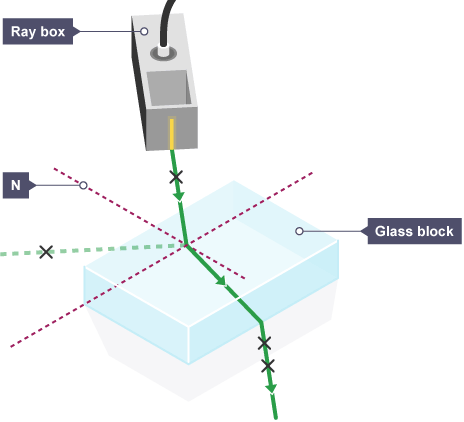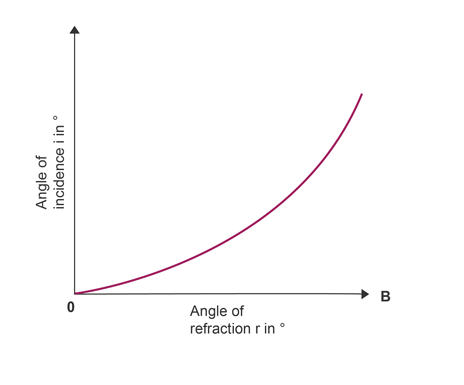5: Angles of incidence and refraction
1/4
There's no tags or description
Looks like no tags are added yet.
Name | Mastery | Learn | Test | Matching | Spaced |
|---|
No study sessions yet.
5 Terms
Low voltage power pack, a 12V ray box, a single slit comb, a rectangular glass block, a sheet of white paper, a protractor, a sharp pencil.

method
Set up the ray box and slit so that a narrow, bright ray of light is produced.
Place the rectangular glass block on a sheet of white paper and draw around it carefully with a pencil.
Remove the glass block. Use the protractor to draw a normal approximately 1/3 of the way along the longest side.
Use a protractor to measure angles of incidence from this normal of 100, 200, 300, 400, 500, 600 and 700. Draw in the incident rays corresponding to these angles and label them A, B, C.... Record these angles of incidence in a suitable table.
Carefully replace the block on the outline. Direct a narrow ray of light along the line marked A. This is the incident ray for the angle of incidence, i = 100.
With the pencil mark two Xs to indicate the direction of the emergent ray. Mark the Xs as far apart as possible.
Remove the block again. Join the Xs with a pencil line, drawn using a ruler. Extend this line back to the block. This is the emergent ray: label it 'A'.
Use the ruler to join the incident and emergent rays together with a pencil line. This is the refracted ray. Carefully mark in the angle of refraction, r, between the refracted ray and the normal. Measure the angle of refraction with a protractor and record in the table.
Repeat the procedure for each of the incident rays, recording angle of incidence and corresponding angle of refraction in the table.
hazards
Hazard | Consequence | Control measures |
Ray box gets hot | Minor burns | Do not touch bulb, allow time to cool |
Semi-dark environment | Increased trip hazard | Ensure environment is clear of potential trip hazards before lowering lights |
possible error
replacing the block carefully on its outline;
ensuring that the power pack is set to 12 V, so that the ray box is at maximum brightness;
doing the experiment in a dark room so that the emergent ray can be easily seen and marked.
conclusion
angle of incidence increases the angle of refection also increases
its not directly proportional
